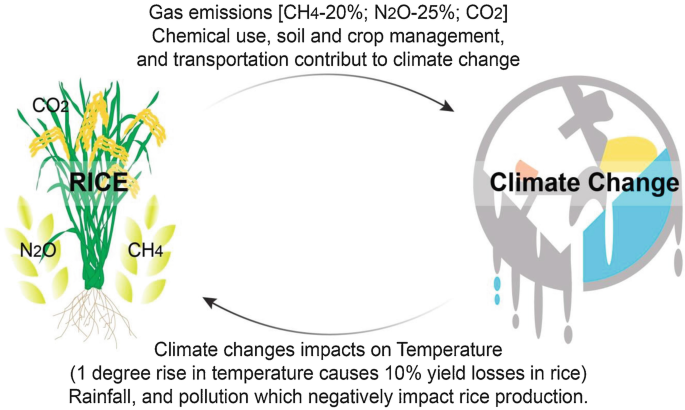Climate change significantly affects rice production, influencing crop growth, yield, and quality through changes in temperature, rainfall patterns, extreme weather events, and atmospheric carbon dioxide levels. As rice is a staple food for over half of the world’s population, understanding and mitigating these impacts is critical for food security. Here’s how climate change affects rice production and potential strategies for adaptation:
1. Temperature Changes
- Impact:
- Increased Temperatures:
- Higher daytime temperatures can accelerate crop growth, reducing grain-filling periods and leading to lower yields.
- Extreme heat during the flowering stage can cause spikelet sterility, reducing grain set and yield.
- Nighttime Temperatures:
- Warmer nights increase respiration rates, reducing the energy available for grain production.
- Increased Temperatures:
- Example: A 1°C rise in temperature can reduce rice yields by 10–20% in tropical regions.
- Adaptation:
- Develop and adopt heat-tolerant rice varieties.
- Shift planting schedules to avoid peak heat periods during critical growth stages.
2. Changes in Rainfall Patterns
- Impact:
- Drought:
- Reduced rainfall during key growth stages, such as tillering and panicle initiation, affects water availability, leading to stunted growth and yield loss.
- Flooding:
- Intense rainfall can waterlog fields, reducing oxygen availability to roots and increasing the risk of diseases like sheath blight.
- Drought:
- Example: In South Asia, erratic monsoons have caused alternating droughts and floods, disrupting rice production.
- Adaptation:
- Use drought- and flood-tolerant rice varieties (e.g., “Swarna-Sub1” for submergence tolerance).
- Implement water-saving irrigation techniques like Alternate Wetting and Drying (AWD).
- Improve drainage systems to mitigate flooding.
3. Rising Sea Levels and Salinity
- Impact:
- Coastal rice-growing regions are increasingly affected by seawater intrusion, leading to salinization of soils.
- Saline conditions inhibit water uptake and nutrient absorption, reducing plant growth and yields.
- Example: Bangladesh and Vietnam, major rice-producing countries, are experiencing salinization in low-lying coastal areas.
- Adaptation:
- Develop and grow salt-tolerant rice varieties.
- Use techniques like raised-bed planting or fresh water flushing to reduce soil salinity.
4. Increased Frequency of Extreme Weather Events
- Impact:
- Cyclones, storms, and heavy rains can destroy crops, damage infrastructure, and delay planting or harvesting.
- Heatwaves and cold spells during critical stages can cause grain sterility or poor grain filling.
- Example: Typhoon Haiyan in the Philippines caused severe damage to rice fields, reducing production significantly.
- Adaptation:
- Build resilient infrastructure, such as raised storage facilities and protective bunds.
- Develop crop insurance schemes to safeguard farmers’ livelihoods.
- Promote agroforestry to buffer the impact of extreme weather
5. Elevated CO₂ Levels
- Impact:
- Increased atmospheric CO₂ can enhance photosynthesis (CO₂ fertilization effect) in rice, potentially boosting biomass production.
- However, the benefits are limited if other factors like nutrients and water are insufficient.
- Elevated CO₂ can reduce grain protein content, affecting nutritional quality.
- Example: Studies have shown a 10–15% increase in biomass under elevated CO₂, but yield benefits are often offset by other climate stresses.
- Adaptation:
- Optimize fertilizer use to match increased crop growth.
- Incorporate nutrient management strategies to maintain grain quality.
6. Increased Pest and Disease Pressure
- Impact:
- Warmer temperatures and changes in humidity can expand the habitat range and lifecycle of pests like brown planthoppers and diseases like rice blast and bacterial blight.
- Stress from climate change makes plants more vulnerable to infestations.
- Example: Brown planthopper outbreaks have become more frequent in Asia due to changing climatic conditions.
- Adaptation:
- Use integrated pest management (IPM) techniques, including biological controls.
- Develop pest- and disease-resistant rice varieties.
- Monitor and predict outbreaks using climate and pest modeling tools.
7. Soil Degradation
- Impact:
- Erratic rainfall and flooding can cause soil erosion and nutrient leaching, reducing soil fertility.
- Salinization and acidification due to changing water dynamics degrade arable land.
- Example: Rice-growing deltas like the Mekong and Ganges are experiencing declining soil health due to climate impacts.
- Adaptation:
- Apply organic amendments like compost or biochar to improve soil health.
- Practice crop rotation and intercropping to restore soil fertility.
- Use conservation tillage to minimize erosion.
8. Shift in Suitable Growing Areas
- Impact:
- Changes in temperature and rainfall may make some traditional rice-growing regions unsuitable for cultivation.
- New areas may become viable, requiring a shift in agricultural zones.
- Example: Northern regions of China may become more favorable for rice cultivation due to warming, while southern areas may face water stress.
- Adaptation:
- Use climate modeling to identify and prepare for shifts in suitable growing regions.
- Provide training and resources for farmers transitioning to new cultivation zones.
9. Reduced Water Availability
- Impact:
- Depleting water resources due to melting glaciers, reduced rainfall, and increased competition for water threaten irrigated rice systems.
- Example: The Indo-Gangetic Plain, a major rice-producing region, faces declining groundwater levels.
- Adaptation:
- Adopt water-efficient irrigation practices like drip irrigation and AWD.
- Promote rainwater harvesting and groundwater recharge techniques.
10. Economic and Social Impacts
- Impact:
- Reduced yields and increased production costs due to climate change can threaten farmer livelihoods.
- Food security risks increase as rice supplies become unstable.
- Example: Smallholder farmers in Southeast Asia bear the brunt of climate impacts due to limited resources for adaptation.
- Adaptation:
- Develop financial tools like crop insurance and subsidies for climate-resilient technologies.
- Foster community-based adaptation strategies and knowledge sharing.
Conclusion
Climate change poses significant challenges to rice production through its impacts on temperature, water availability, pests, diseases, and soil health. However, a combination of technological innovations, sustainable farming practices, and policy interventions can help mitigate these effects. Investing in climate-resilient rice varieties, improving water and soil management, and empowering farmers with knowledge and resources are essential for ensuring the sustainability of rice production in a changing climate.
Hashtags
#ClimateAction #SustainableDevelopment #AgriculturalSustainability #ClimateChangeSolutions #RiceHarvest #ClimateResilience #SustainableFoodSystems #ClimateJustice #RiceIndustry #SustainableAgriculture #ClimateAdaptation #RiceFarmers #ClimateAwareness #SustainableFarmingPractices #ClimateSmartFarming #RiceProduction #SustainableRice #ClimateChangeMitigation #RiceEcosystem #SustainableRiceProduction









